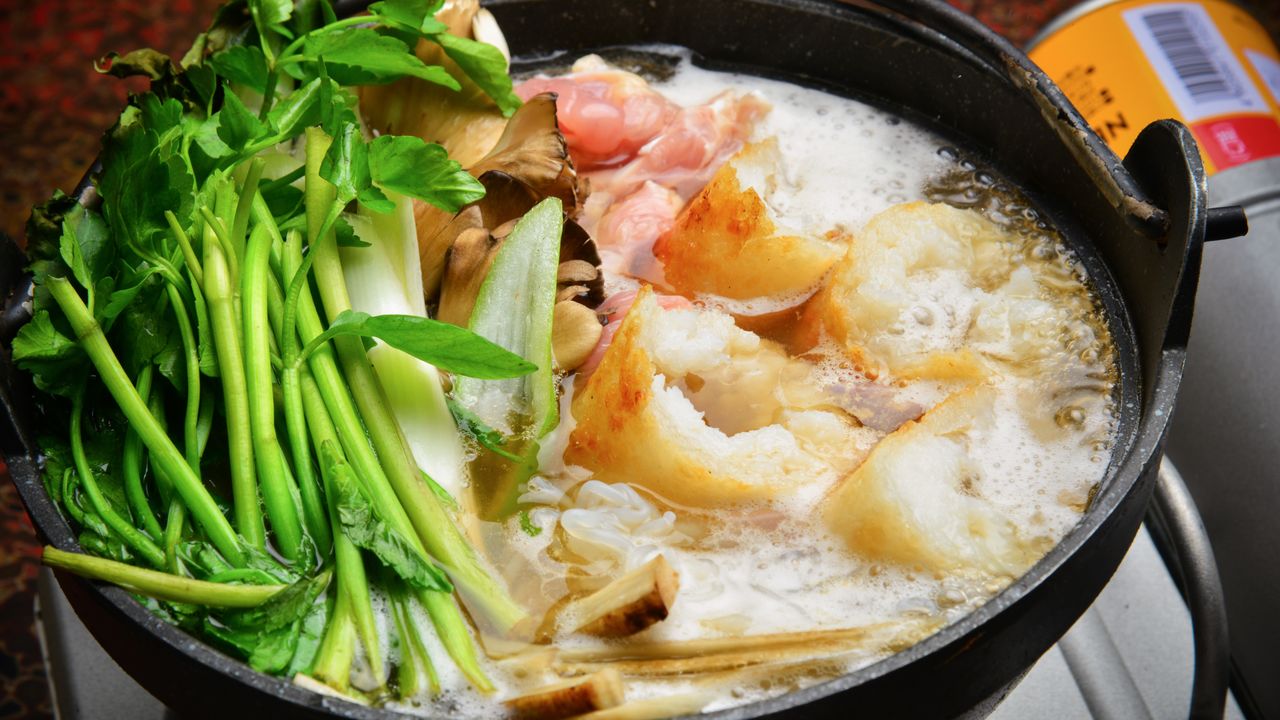
Hot Meals from the Cold North: Three Homegrown Akita Stews
Guideto Japan
Travel Food and Drink- English
- 日本語
- 简体字
- 繁體字
- Français
- Español
- العربية
- Русский
The Rich Chicken Broth of Kiritanpo-nabe
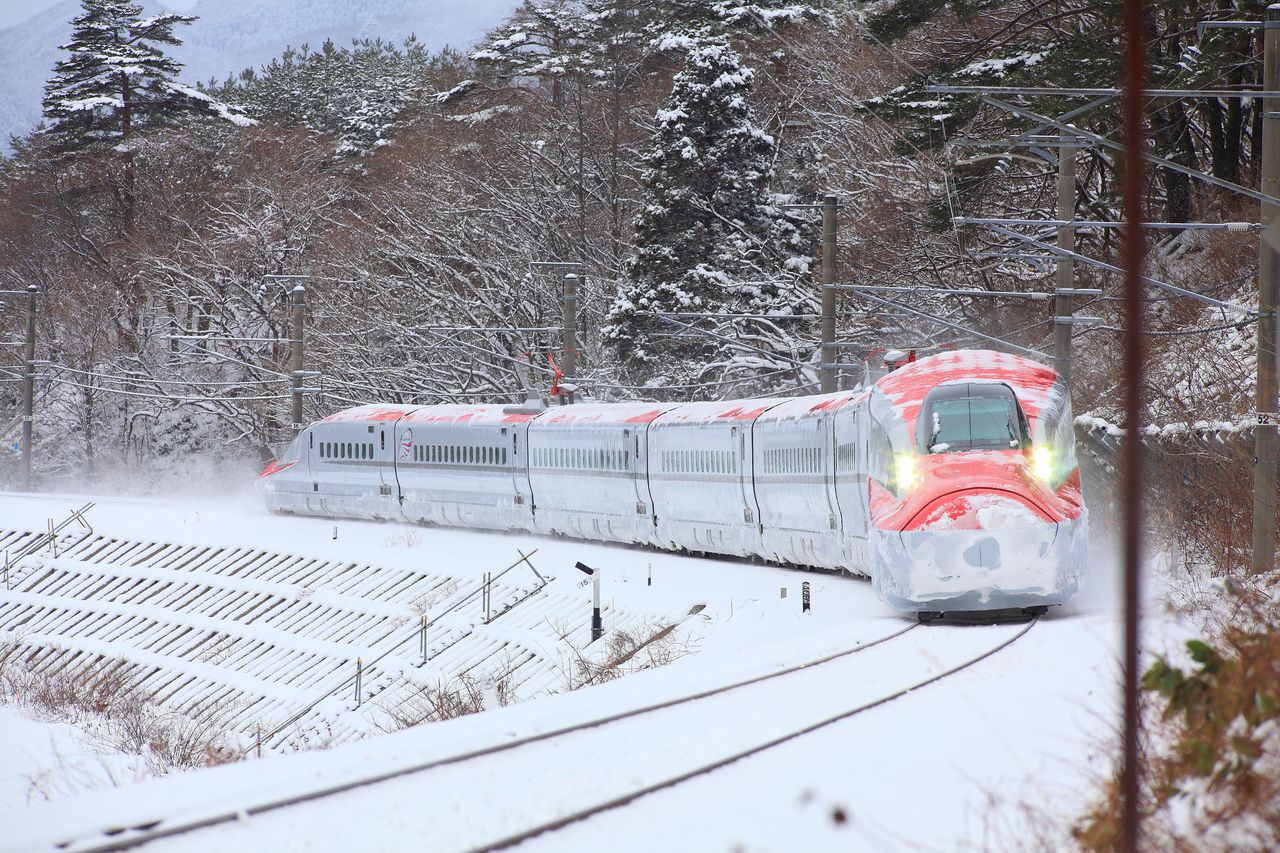
The Komachi Akita Shinkansen powers its way through the snow that is part and parcel of the harsh Akita winter. (Courtesy Akita Tourism Federation)
Kiritanpo-nabe is first and foremost among Akita’s local stew dishes. Kiritanpo is made from crushed, cooked rice, which is wrapped around sticks and toasted. The resulting cylindrical treat is steeped in a broth of hinai-jidori (a variety of chicken native to Akita), and ingredients like maitake mushrooms and seri parsley are added. A recommended variant is miso-tanpo, in which miso is added to the kiritanpo before toasting.
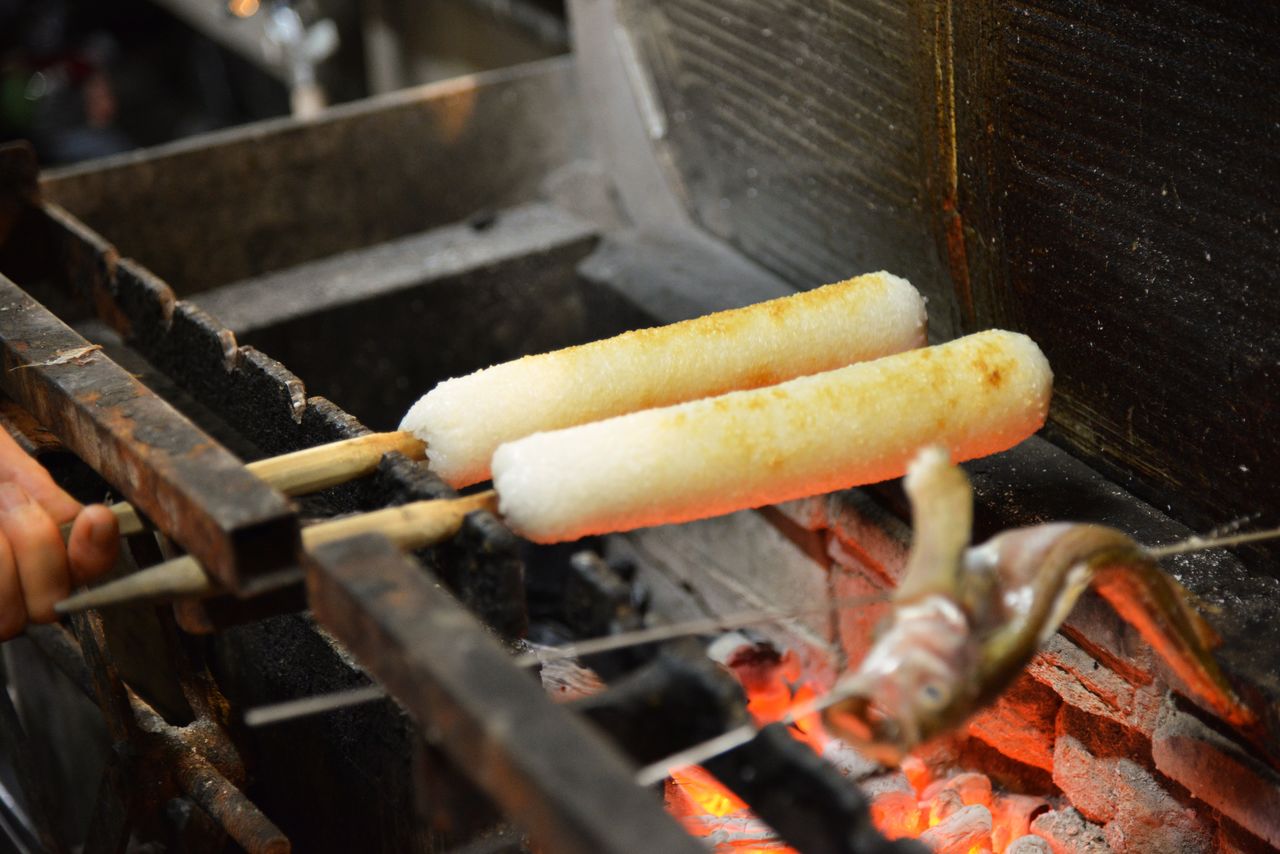
Kiritanpo are flame-toasted before finding their way into the stew pot.
The Kuidokoro-Hokushū restaurant in the city of Akita is famed for making kiritanpo only after customers place their orders. Each kiritanpo is made from two bowls worth of cooked rice, thoroughly toasted over open flame, and finally steeped in a rich, savory broth. It remains firm, then melts in the mouth, imparting an exquisite, almost addictive, mouthfeel.
Hinai-jidori is a breed of hinai-dori, a protected foundation stock of poultry, which has been cultivated with delicious meat in mind. This chicken breed is considered one of the three great breeds of locally bred Japanese poultry, together with the Satsuma-jidori of Kagoshima and the Nagoya Cochin of Aichi. It’s the perfect match for kiritanpo-nabe, with just the right texture to sink one’s teeth into and a rich, savory, slightly fatty flavor. Chicken dishes are highly recommended for visitors to Akita.
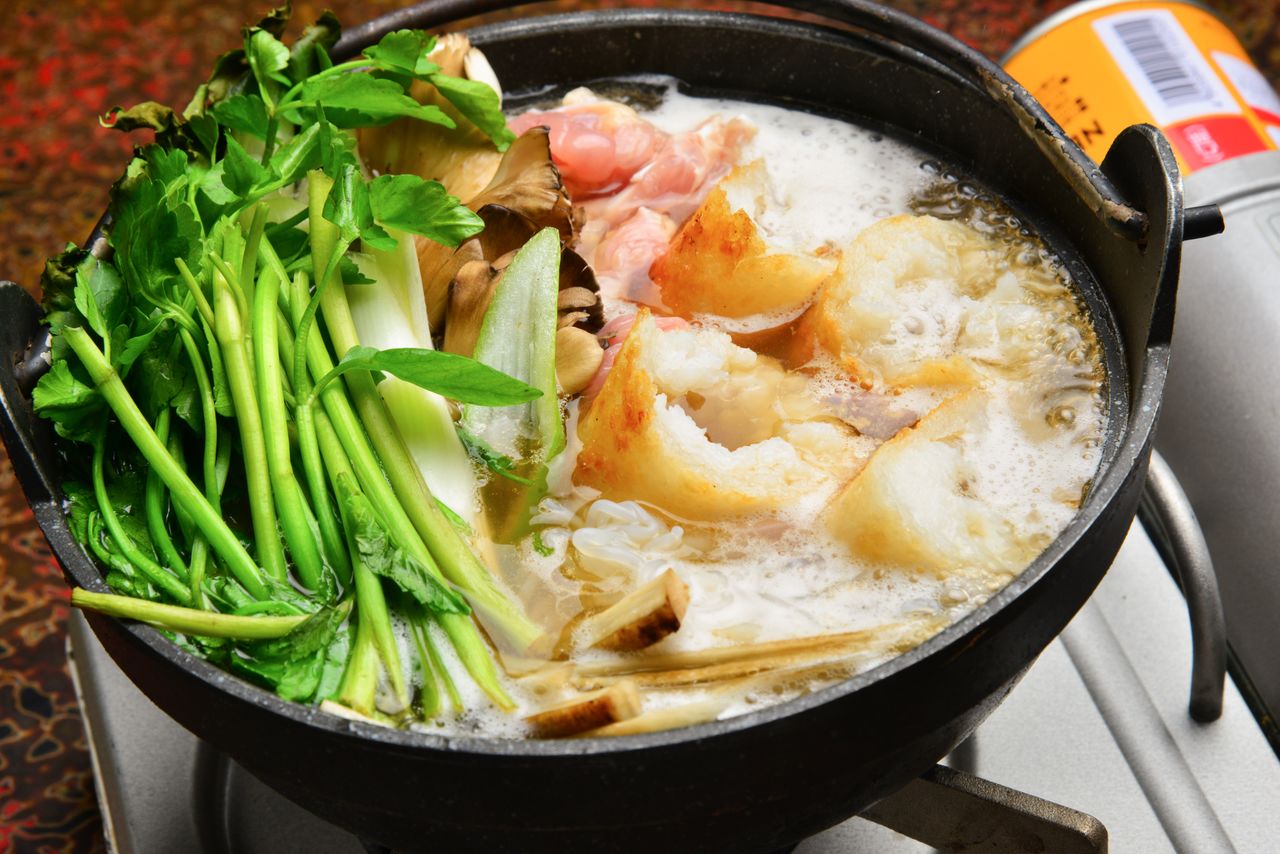
Customers can order kiritanpo-nabe in servings for one or more persons.
Kuidokoro-Hokushū
- Address: 4-1-1 Ōmachi, Akita-shi, Akita Prefecture
- Access: 15 minutes’ walk from JR Akita Station
- Tel.: 018-863-1316
- Hours: 5:30–11:00 pm, Mon.–Sat. (last seating at 10:00 pm)
Great Balls of Rice: Damakko-nabe

At ping-pong-ball size, damakko dumplings make a perfect mouthful.
Damakko-nabe, almost as popular as kiritanpo-nabe, is made according to almost the same recipe. A key difference is that damakko (dumplings made of crushed rice) are balled up instead of toasted on a stick. Akita is known for its Akita-Komachi and Hitomebore rice strains, and these two kinds of nabe afford the opportunity to experience the quality of these local rice varieties.
The damakko-nabe at the Chawan-ya restaurant is particularly noteworthy for the addition of ground shrimp to the damakko. The added shrimp flavor goes very well with the hinai-jidori soup broth: one taste just isn’t enough. A variety of mushrooms give the broth a bit of body, warming the body from the inside out. The eatery offers a variety of jizake (locally brewed sake), any of which would make a delicious pairing with this dish.
Chawan-ya
- Address: 4-2-7 Ōmachi, Akita-shi, Akita Prefecture
- Access: 15 minutes’ walk from JR Akita Station
- Tel.: 018-864-5202
- Hours: 5:00 pm–11:00 pm, Tues.–Sun.
Shottsuru-nabe, a Stew for Fish Lovers

This dish provides the total taste experience of hatahata (Japanese sandfish). (Courtesy Akita Kawabata Isariya Sakaba)
Shottsuru-nabe is a classic Akita stew featuring shottsuru, a sauce made of salted and fermented hatahata (Japanese sandfish). While it may be an acquired taste, its mild body makes a positive addition to the dish’s simple broth. Typical ingredients include such vegetables as hakusai (Chinese cabbage) and shungiku (garland chrysanthemum), and hatahata fish themselves, included whole with roe known as buriko.
Hatahata, the official fish of Akita prefecture, is at its most flavorful in November and December. It is caught off the Akita coast in the Sea of Japan, making it a quintessential taste of winter in the region. At the Akita Kawabata Isariya Sakaba restaurant, hatahata caught at their peak are kept on ice, allowing customers to have shottsuru-nabe year-round. The dish offers a delightful combination of tender hatahata meat and the crunchy texture of buriko. Namahage, frightening spirits that normally visit children in the New Year, put on a show for customers around 9:00 every evening.
Akita Kawabata Isariya Sakaba
- Address: 4-2-35 Ōmachi, Akita-shi, Akita Prefecture
- Access: 15 minutes’ walk from JR Akita Station
- Tel.: 018-865-8888
- Hours: 5:00 pm–12:00 am, year-round
Nearby Attraction: Sake-Navi, Akita’s Great Sake Kingdom
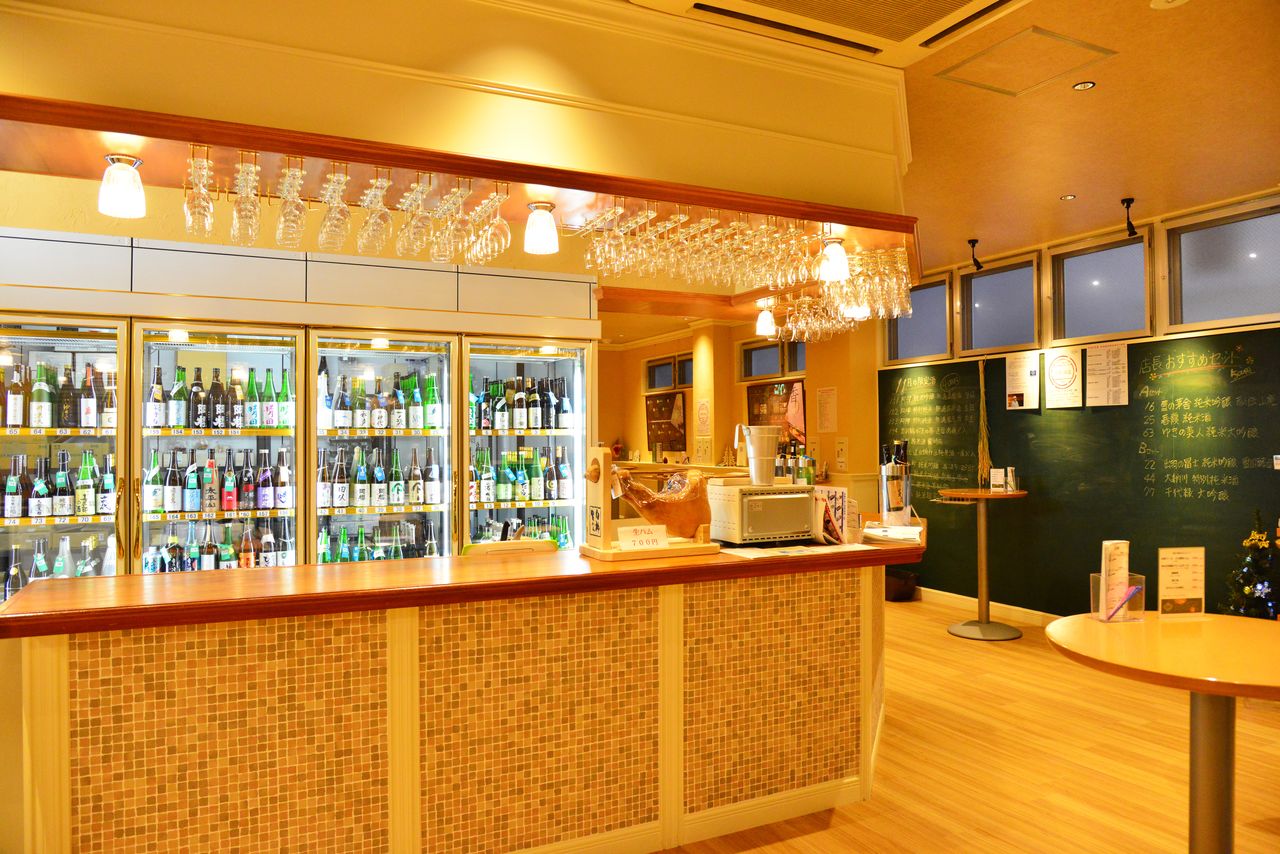
An assortment of distinctive local sake worthy of the brewing powerhouse that is Akita.
At Sake-Navi, Akita’s Great Sake Kingdom, over 120 kinds of jizake from 36 Akita Prefecture brewers are offered for patrons to sample in the comfort of a standing bar area. In addition to its extensive lineup of great brands, another reason for the bar’s popularity is that prices start at an affordable ¥250 per glass. A recommended offering is the okonomi-kiki-zake-set, which offers tastes of three kinds of jizake of one’s choice for just ¥500. Customers can purchase bottles of the labels they like best to savor at home. The bar also periodically hosts such events as Kura-no-hi (storehouse days) and Kiki-zake-no-hi (sake tasting days). Check the store website for more information in Japanese.
Sake-Navi, Akita’s Great Sake Kingdom
- Address: 5-2-1 Ōmachi, Akita-shi, Akita Prefecture
- Access: 20 minutes’ walk from JR Akita Station
- Tel.: 018-893-6405
- Web: http://www.osake.or.jp
- Hours: 4:00 pm–9:00 pm, Mon.–Sat. (last entry at 8:45)
(Originally published in Japanese. Reporting, text, and photography by Shoepress. Banner photo: Kiritanpo-nabe, the best known of the Akita stew dishes.)